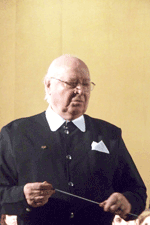> [Archived] Chronicles

The 'George Enescu' Philharmonic Conducted by Octav Calleya Performed at the Romanian Athenaeum
The genuine stained glass repertoire embedded the Spanish chords echoing Jules Massenet's view in the technical virtuosity and the sound amplitude that characterize Camille Saint Saens and the vibrant tunes taken from Verdi's compositions. Jules Massenet's ballet suite Le Cid is based on the tessellated Spanish dances taken from different parts of the country. The dances reached one of the most varied and opposite tunes, which were glued together by the Spanish style despite their swing from the frolicsome stage to the dramatic one, from lyricism to eroticism. The rhythms, the poignant tunes and the specific ornaments were highlighted and carefully framed by the Symphonic Orchestra of the "George Enescu" Philharmonic conducted by Octav Calleya. Perhaps Camille Saint Saens' Concert nr.2 op.22 in G Minor is his most known piano concert. The tunes' opulence that remarkably stands out was eloquently rendered by the young pianist Gabriela Ungureanu. Starting with the piano's austere and restrained theme, the music develops gradually interweaving the orchestra with elements of light and colour; it reaches the acme of the technical virtuosity lined with the orchestral chords as to come back to the dramatic theme.
The second part of the concert depicted a different universe of sounds that emphasised freedom, the dance rhythms, the game of the compasses kept on by the piano and by the dialogue of the soloist with the orchestra. Considering all this, the performance was lively, fluid and erratic.
More than ever, the composer shed light on the technical virtuosity in the third part of the concert. Whilst the second part boasted energy, the third one represented an ebullient, volcanic attempt laden with vigour and élan, features that were strongly pointed up by the soloist and the orchestra and meticulously controlled by the conductor Octav Calleya.
Of course, the numerous audiences appreciated the talented pianist Gabriela Ungureanu, her technique and impressive voice; eventually, the rapturous applauses were gratified with an encore of Jean Philippe Rameau's The Egyptian.
There was a perfect symmetry of the 2013 events (also entitled Verdi Year) and the last part of the concert in which the orchestra, the philharmonic's choir and the choirmaster Iosif Ion Prunner rendered overtures and choirs of Verdi's compositions.
As some of you might have expected, the conductor Octav Calleya expressed his wish that the repertoire based on Verdi's compositions was to end with La Traviata - Brindisi, a nice last success which the audience warmly welcomed.
Translated by Sorina Cimpoeru and Elena Daniela Radu
MTTLC, Bucharest University














